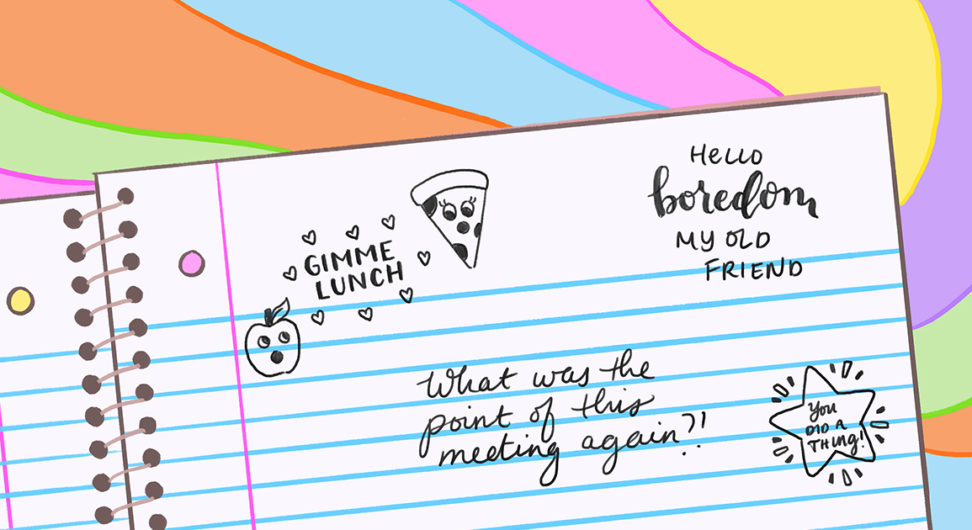Creative Briefs #2: The Recurring Call
The invite snuck into everyone’s inbox under the guise of Sync with Marketing. In most cases, this was code for a 30 minute meet-and-greet that required no preparation except finding a blank page in one’s notebook. These initial engagements were like a first date, a chance to read the style of the other team and get a feel for what it’s going to be like to work together. Align our objectives, define the path forward, blah blah blah. What Haley enjoyed most about these meetings was watching Lois and Roland fill the margins of their steno pads with fantastic fictional scenes.
It was only when the auto-reminder popped up that she noticed the meeting was with GTC — a.k.a the Global Trade Consortium, a trade group apparently named decades ago when corporations wanted to sound serious and important. Now, Haley thought it sounded like an evil corporate monolith featured in a James Bond movie. “Does it seem weird to anyone else that GTC is an industry trade group that doesn’t include the industry in the title? And at risk of sounding like a copywriter, the world is split on the pronunciation of consortium, so the name conjures the long-dormant anxiety of a grade school spelling test.”
“Oh shit,” Lois blurted, “is that who this call’s with? Do we really have to go through this again?” They met with GTC once or twice a year, yet it felt like starting over every time they got on a call.
“They’re a strategic partner,” Paul said without looking up. “They want to discuss possible synergies moving forward.” When Haley laughed, Paul asked what was funny.
“Um, I thought you were. You sound like you’re reading from LinkedIn.”
Lois laughed. “It’s how corporate America talks, Hale-storm. Better find some bandwidth to integrate that verbiage into your personal brand before you get rightsized.”
Paul kept typing. “They asked for the meeting. They want to meet Karen. She’s been Marketing VP for nine months and they’ve never talked to her.”
Haley smiled. This time it was Karen, though there was always someone new on these calls, and that made every meeting feel like deja vu: new team members would be introduced, Haley would bond with their copywriter over a serial comma joke, Roland would make a UI joke with their web designer, the overlap of too many people talking at once would be punctuated with awkward pauses, someone would remind everyone of the 10,000-foot view of each company, and 30 minutes later, the list of action items would be blank. It was like relatives at a holiday party agreeing that they really should get together more, easy promises that were even more easily broken. “Yeah, they should meet her. It’s important to know the people you aren’t going to be working with.”
Haley thought about that — at this moment, how many people, at how many companies, were sitting in conference rooms sketching cartoon dogs and Celtic knots and half-empty coffee cups, biding their time before they could get back to their actual work? How much of America’s corporate productivity was being put on hold because someone called a meeting with no clear agenda, trapping attendees in taupe-colored rooms while banal banter flowed from the speakerphone?
Paul finally stopped typing. “Guys, it’s their meeting. They’re a partner. They’re being proactive, and you’re being whiners.”
“I’m not a whiner,” Lois said in her best whiny tone.
“We should totally do buzzword bingo,” Roland suggested. He flipped open his notebook, sketched a grid, and started filling in the boxes. “Synergy…scalable…best practices…low-hanging fruit…”
“I’m in if we make it a drinking game,” Lois said.
Paul stood up and gathered the things he’d be bringing to the meeting. “I don’t know why you’re complaining. All you guys have to do is sit in the conference room for 30 minutes and doodle mermaids and magical dogs or whatever it is you draw.”
Haley thought about that — at this moment, how many people, at how many companies, were sitting in conference rooms sketching cartoon dogs and Celtic knots and half-empty coffee cups, biding their time before they could get back to their actual work? How much of America’s corporate productivity was being put on hold because someone called a meeting with no clear agenda, trapping attendees in taupe-colored rooms while banal banter flowed from the speakerphone?
She imagined someone, somewhere, was diligently poring over data in order to calculate the financial impact of making otherwise efficient people gather in a room and stop working. They’ll crunch the numbers into a vivid colorful infographic, underscoring every skeptic’s suspicion while having no impact on the frequency of such events.
Maybe she could open an Etsy store and peddle the myriad doodles that emerged from these completely unnecessary attendance-required meetings. Or would that business model fail because everyone who got the joke already had unlimited access to similar artwork, found for free in the recycling boxes of their own conference rooms?
She’d bring it up with Lois later. For now, she flipped to a blank page in her notebook and walked to the conference room.
This work is licensed under a Creative Commons Attribution-ShareAlike 4.0 International License.


